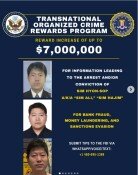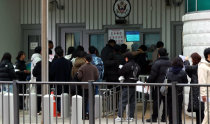ROK, U.S. Agree on Approach to North
ROK, U.S. Agree on Approach to North
Posted September. 16, 2006 03:50,
The U.S. and South Korea have agreed on a common and comprehensive approach towards North Korea. The key objective of the approach is to persuade North Korea to return to the six-party talks. It aims to reduce intension over financial sanctions imposed on the communist country by combining other issues associated with the implementation of the September 19 Joint Declaration and the financial sanctions. The reclusive nation insists on the lifting of the sanctions first and talks later, but the U.S. demands the discussion of the issue to take place within the six-party framework. With the new approach, the U.S. and Korea want to bring about a new breakthrough to the current stalemate. However, even if China and Russia bridge their differences in consultation with the U.S. and Japan, it could become invalid if North Korea does not accept it.
Long Way to Go-
The Korean government is negotiating with the U.S. on the implementation process of the Joint Declaration with the inclusion of the financial sanction on North Korean frozen accounts (BDA accounts in Macao). The gradual steps include North Koreas abandonment of its nuclear ambition, supply of light water to the North, embarking on the elimination of nuclear materials, and energy assistance to the North.
Assumption for this is the U.S. will ease its regulations on BDA, with some strings attached. This would allow North Korea to come back to the negotiating table without losing face.
The Korean government plans to have an agreement on the issue with the U.S. and Japan first. Then, it will suggest its final version agreement to the elusive North after having consultation with China and Russia by the end of September.
The government hopes that bilateral talks between the U.S. and the North will be held during the process. It is believed that the government did not miss North Koreas positive response to the outline of the approach.
However, it does not rule out any possibility that the communist state could resist it. The reality is that the U.S. cannot accept North Koreas demand to lift sanctions, due to the principle of U.S. diplomatic policy. The trick is whether the North can also offer a concession to the U.S. by accepting only part of its total frozen accounts of up to $24 million in BDA.
The U.S. is likely to constantly impose pressure on the North, separating from its negotiation on the comprehensive approach, which is likely to prompt North Korean defiance. If the North re-launches its missiles or resumes its nuclear programs, the ongoing effort will be in vain.
Background for the Comprehensive Approach-
Song Min-soon, head of the Office of Unification, Foreign Affairs and Security Policy Planning, and Cheon Yeong-woo, the head of the peace negotiation office on the Korean peninsula under the Ministry of Foreign Affairs and Trade, have recently negotiated in detail with the U.S., China, and Japan by visiting those countries.
China is understood to have showed a negative response to the detailed plan Mr. Song explained last month upon his visit to China. It said, Do we even have to pursue such things?
To the U.S. request to hold 2+2 meeting, Ban Ki-moon, the Minister of Foreign Affairs and Trade, Song Min-soon and U.S. Secretary of State Condoleezza Rice, National Security Advisor Stephen Hadley held a meeting on the issue in Washington right before the Korea-U.S. conference. According to the government, this was the result of Rices active efforts to push the comprehensive approach. The original title of it was a common and broad approach, but it switched to a common and comprehensive approach during the negotiations, as they have agreed that the term comprehensive is less burdensome to involved countries than is the word broad.
gun43@donga.com





![교육부 장관인가, 교사부 장관인가[오늘과 내일/우경임]](https://dimg.donga.com/c/138/175/90/1/wps/NEWS/IMAGE/2025/12/26/133045801.1.png)

